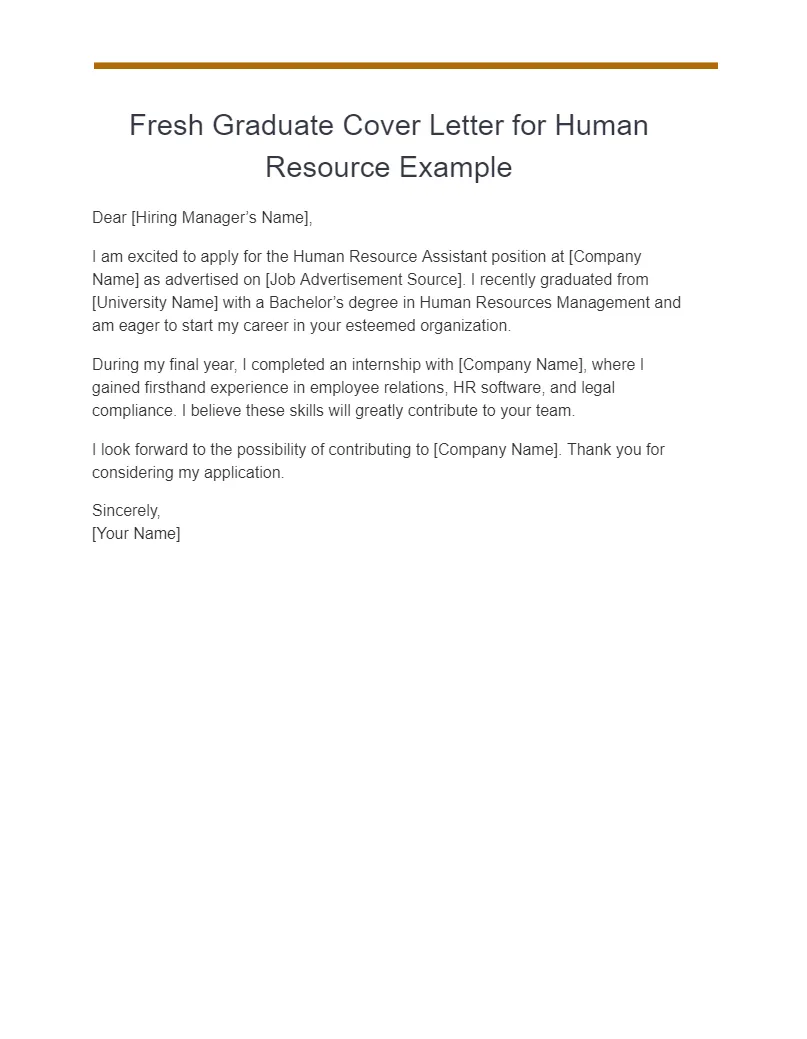What is a Cover Letter for Fresh Graduates?
A cover letter for fresh graduates is a crucial document that accompanies your resume when applying for a job. Unlike your resume, which provides a summary of your skills and experience, a cover letter allows you to express your personality, showcase your passion for the role, and explain why you are the perfect fit for the company. For fresh graduates, who may lack extensive work experience, a well-crafted cover letter becomes even more important. It’s your opportunity to demonstrate your potential, enthusiasm, and understanding of the job requirements. A strong cover letter can significantly increase your chances of getting noticed by hiring managers and securing an interview. It should be tailored to each specific job application, highlighting relevant skills, academic achievements, and any extracurricular activities or projects that demonstrate your capabilities. This is also your chance to explain any gaps in your resume, such as lack of direct work experience, and to emphasize your willingness to learn and contribute to the organization.
Key Components of a Cover Letter for Fresh Graduates
A successful cover letter comprises several key components that work together to create a compelling narrative. Understanding these elements is essential for creating a document that effectively captures the reader’s attention and showcases your qualifications. Each component should be carefully considered and tailored to the specific job and company you are applying for. By focusing on these key areas, you can ensure your cover letter stands out from the competition and leaves a lasting positive impression. Proper structuring and clear communication are vital. Your cover letter should be professional, well-organized, and easy to read, avoiding lengthy paragraphs and convoluted sentences. A well-written cover letter provides hiring managers with a snapshot of your potential and demonstrates that you have taken the time to understand the role and the company.
Contact Information
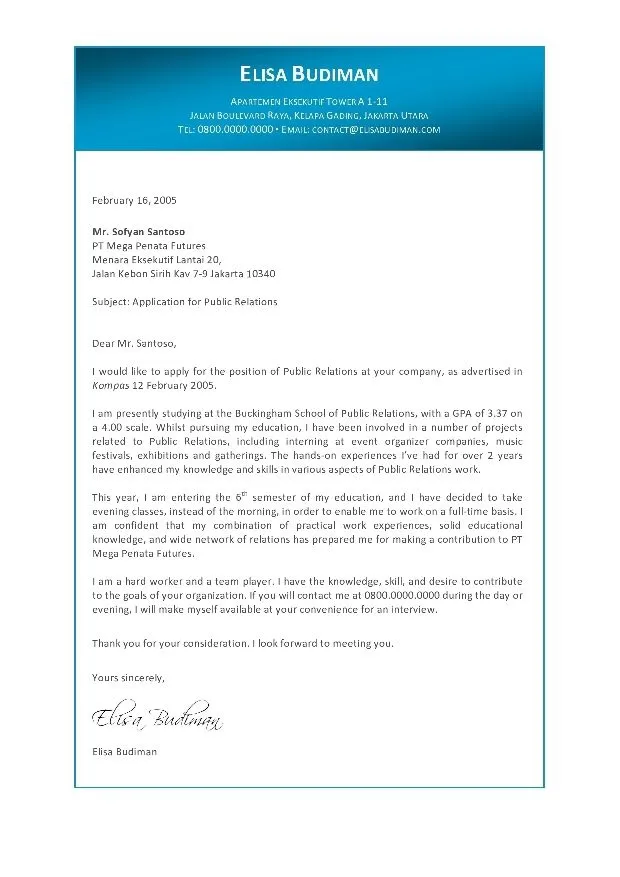
Start your cover letter with your contact information. This section includes your full name, phone number, email address, and optionally, your LinkedIn profile URL. Make sure your email address is professional and easy to read. This is the first thing the recruiter will see, so it’s important to create a good impression from the start. Include a recent and professional-looking headshot on your LinkedIn profile to further enhance your professional image. Verify that all your contact details are accurate and up-to-date. This simple step is crucial, as providing incorrect information can lead to missed opportunities and frustration.
Your Name and Contact Details
At the top left or right of the cover letter, include your full name, followed by your phone number and professional email address. These details are essential for the recruiter to reach you. Double-check for accuracy before sending, as incorrect information can lead to missed opportunities. Ensure your email address is appropriate for professional communication; avoid using nicknames or informal language. This is a crucial first step in making a positive impression.
Date and Recipient Information
Below your contact information, write the current date, followed by the recipient’s details. If possible, address your letter to a specific person, such as the hiring manager, by name. Research the company to find out who is responsible for hiring, as this shows that you’ve taken the initiative to personalize your application. If you are unable to find a specific name, use a professional salutation, such as “Dear Hiring Manager”. Include the company name, department, and address to complete this section. If the job posting doesn’t specify a contact person, search the company website or LinkedIn to find one. This personal touch can distinguish your application.
Professional Salutation
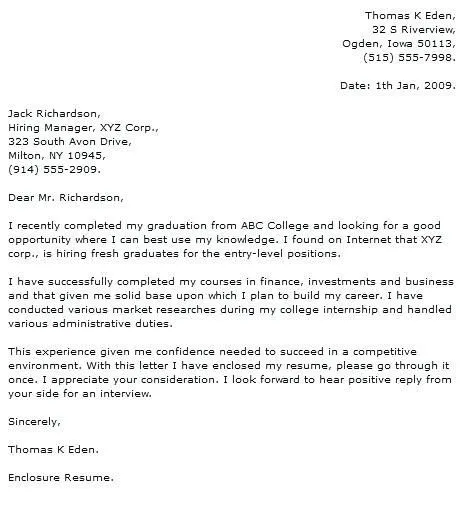
Begin your cover letter with a professional salutation. The most common and appropriate salutation is “Dear Mr./Ms./Mx. [Last Name],” if you know the hiring manager’s name. If you don’t know the name, you can use “Dear Hiring Manager,” “Dear [Department Name] Team,” or a similar professional greeting. Avoid generic greetings like “To Whom It May Concern,” which can make your letter seem impersonal. Ensure that you spell the recipient’s name correctly, as this attention to detail demonstrates respect and professionalism. The tone of your salutation sets the tone for the rest of your letter, so make sure it’s formal and appropriate.
Crafting a Compelling Opening
The opening of your cover letter is your first chance to make a strong impression, so it’s crucial to grab the reader’s attention immediately. Avoid generic opening lines such as “I am writing to apply for the position…” Instead, start with a strong statement that highlights your enthusiasm for the role or the company. You could mention where you found the job posting and why you are interested. Another effective approach is to briefly mention a key skill or achievement that aligns with the job requirements, showcasing your value from the outset. For instance, you can highlight a project you’ve worked on or a skill that makes you a good fit for the role. This will instantly engage the recruiter and encourage them to read further. Ensure that your opening reflects your genuine interest in the position and the company. It will set the stage for the rest of your letter.
Highlighting Your Skills and Education
In the body of your cover letter, the focus should be on highlighting your skills and education, showcasing your suitability for the role. Analyze the job description carefully and identify the key skills and qualifications the employer is seeking. Then, provide specific examples from your academic projects, internships, or extracurricular activities that demonstrate these skills. For fresh graduates, education is often a significant part of your background. Mention relevant coursework, academic achievements, and any specializations or areas of study that align with the job requirements. Use action verbs to describe your accomplishments and responsibilities. For example, instead of saying “I was responsible for,” say “I managed,” “I developed,” or “I led.” The goal is to paint a clear picture of your abilities and how you can contribute to the company. Make sure to align your skills with the employer’s needs, emphasizing what makes you a valuable asset.
Showcasing Relevant Experiences
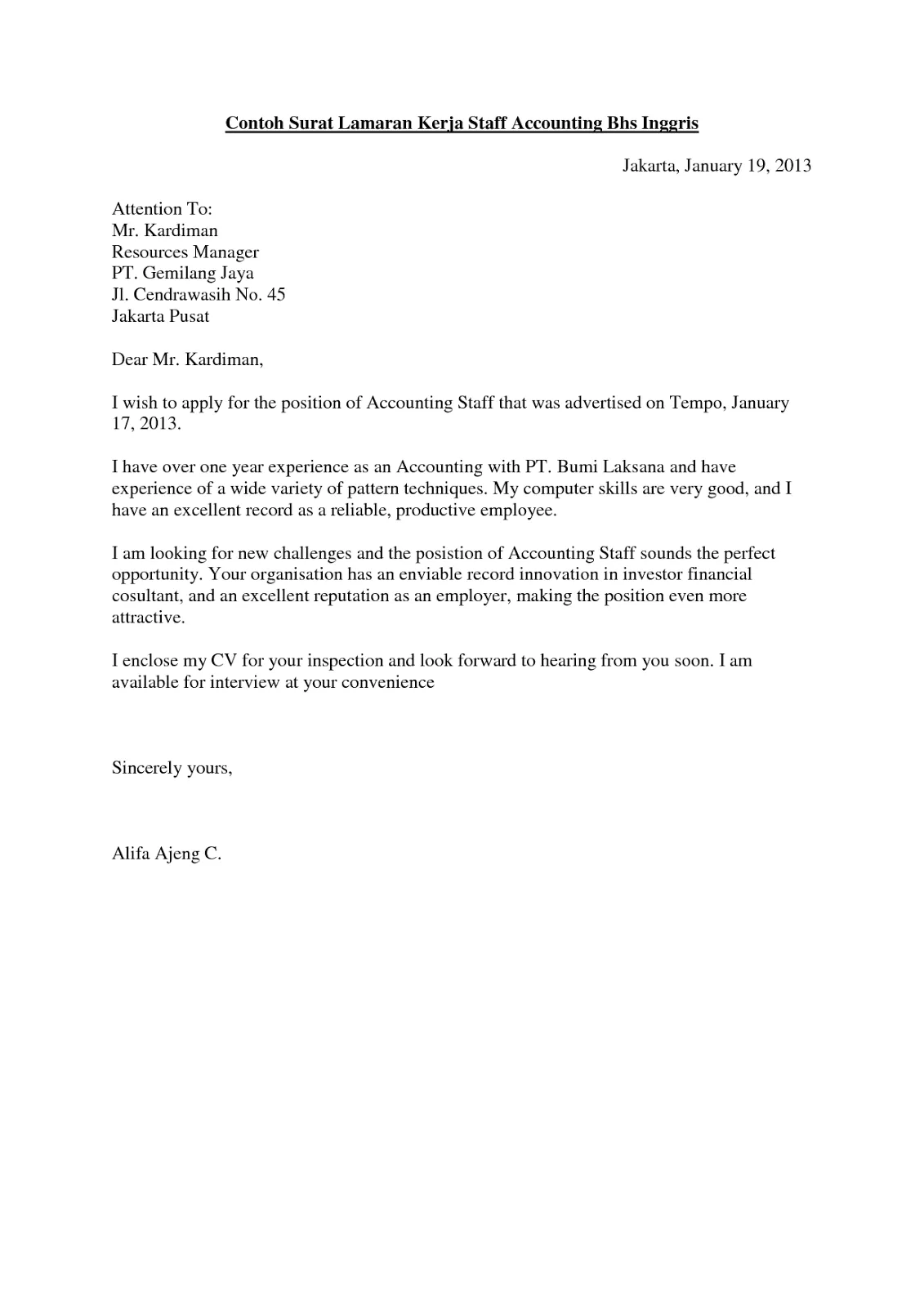
Since fresh graduates often lack extensive work experience, it’s crucial to showcase any relevant experiences you do have. This includes internships, part-time jobs, volunteer work, and any projects or activities from your academic career. Use this section to demonstrate how your experiences have prepared you for the job. Describe the tasks you performed, the skills you developed, and the results you achieved. Quantify your accomplishments whenever possible. For example, instead of saying “I improved customer service,” say “I improved customer service satisfaction by 15%.” If you have participated in any group projects, highlight your role and contributions to the team. This shows your ability to work collaboratively and achieve common goals. Focus on demonstrating transferable skills such as communication, problem-solving, and leadership, which are valuable in any professional setting.
Tailoring Your Cover Letter to the Job
One of the most important strategies for creating a successful cover letter is to tailor it to each specific job application. Generic cover letters that aren’t customized to the job requirements and the company’s culture often get overlooked. Before you start writing, carefully review the job description. Identify the key skills, qualifications, and experiences the employer is seeking. Then, use your cover letter to show how your skills and experiences align with those requirements. Highlight the specific projects you’ve worked on, the skills you’ve developed, and the achievements you’ve accomplished. If you’ve researched the company, mention specific aspects of their work or mission that resonate with you and explain why you want to be a part of their team. Use the same keywords and phrases from the job description in your cover letter to demonstrate that you understand the role and what the employer is looking for. This personalization shows that you have taken the time to understand the role and are truly interested in the opportunity.
Addressing Specific Job Requirements
When tailoring your cover letter, specifically address the requirements outlined in the job description. Identify the key skills, qualifications, and experiences the employer is looking for and highlight your corresponding abilities. Provide concrete examples of how you have demonstrated these skills in the past. If the job description mentions specific software, tools, or methodologies, be sure to include your experience with them. If the job requires communication skills, provide examples of how you have effectively communicated in previous roles or projects. If it calls for problem-solving skills, describe how you have addressed challenges and found solutions. By directly addressing these requirements, you demonstrate that you are a strong fit for the position and have the necessary skills to succeed. Make sure to show how your skills will benefit the company and contribute to its goals.
Quantifying Your Achievements
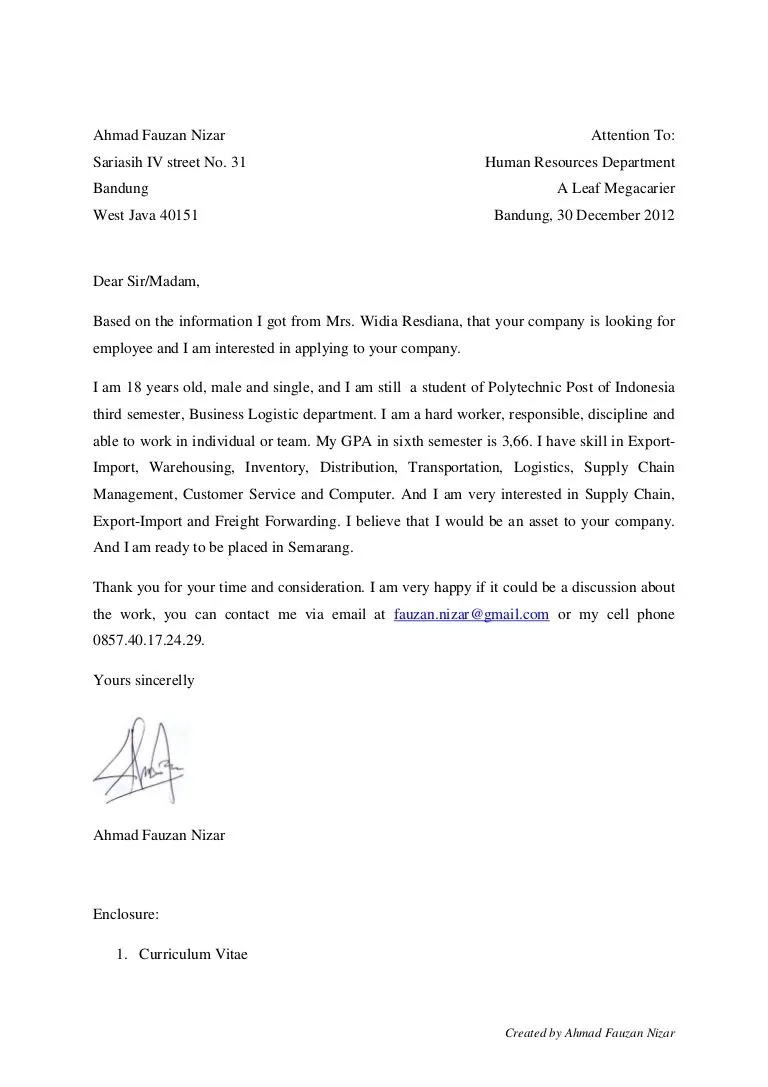
To make your cover letter even more compelling, quantify your achievements whenever possible. Use numbers, percentages, and specific data to illustrate the impact of your work. For instance, instead of saying “I improved customer satisfaction,” say “I improved customer satisfaction scores by 15%.” Instead of saying “I managed social media accounts,” state “I managed social media accounts, increasing follower engagement by 20%.” Quantifiable results provide concrete evidence of your abilities and make your claims more credible. When describing your academic projects or internships, include metrics that showcase your contributions. This helps the reader understand the scope and impact of your work. Using measurable results shows that you can deliver tangible outcomes and adds significant value to your application.
Demonstrating Enthusiasm and Fit
A cover letter should not only highlight your skills and experience but also demonstrate your enthusiasm for the role and the company. Show genuine interest in the position by expressing your passion for the work and the industry. Research the company and mention specific aspects of their mission, values, or projects that resonate with you. Explain why you are excited about the opportunity and what makes you a good fit for their culture. Avoid generic statements and instead, tailor your letter to the specific company and role. Your enthusiasm can set you apart from other candidates. It demonstrates that you are motivated, engaged, and likely to contribute positively to the team. Show your genuine interest in joining the company and the role.
Closing Your Cover Letter Effectively
The closing of your cover letter is an important opportunity to reiterate your interest in the role and encourage the hiring manager to take the next step. Keep the closing concise and professional. Express your gratitude for the reader’s time and consideration. Reiterate your enthusiasm for the position and the company, restating why you are a great fit. Then, include a clear call to action. For instance, you could write “I am eager to discuss my qualifications further in an interview.” Or, “I look forward to hearing from you soon.” Conclude with a professional closing, such as “Sincerely,” or “Best regards,” followed by your typed name. Make sure your closing matches the tone of the rest of your letter. This reinforces your professionalism and reinforces your desire for the job.
Expressing Gratitude and Next Steps
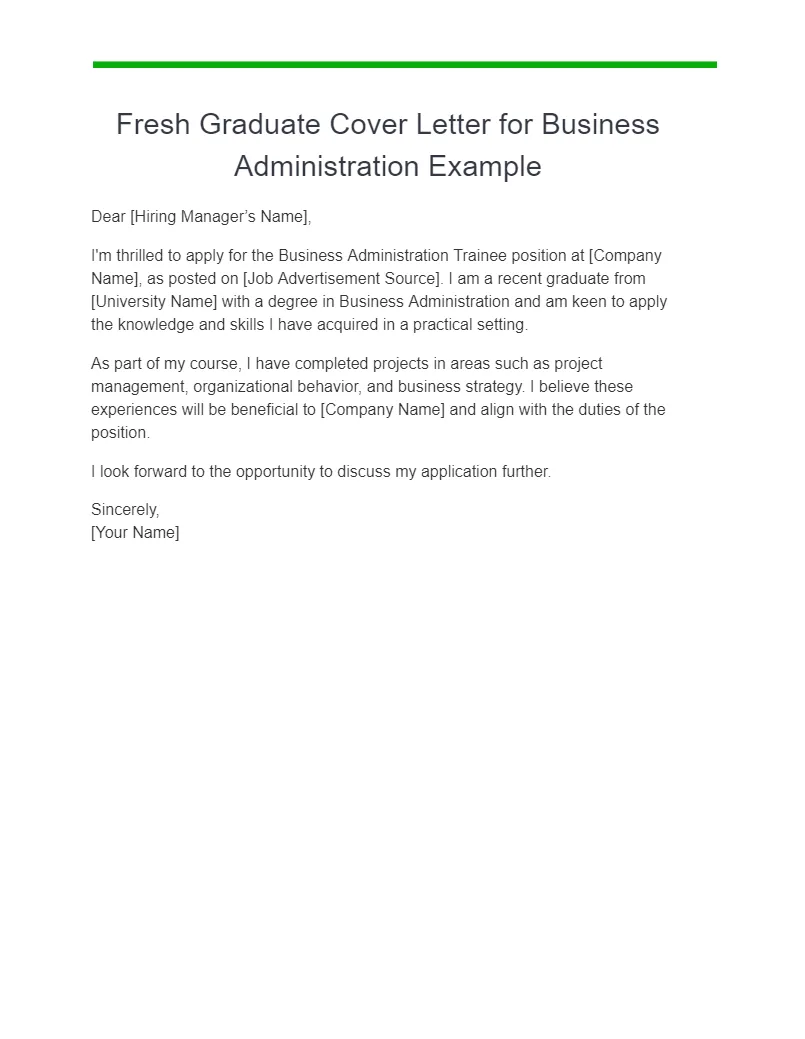
End your cover letter by expressing your gratitude for the hiring manager’s time and consideration. Thank them for reviewing your application and acknowledging their effort in the hiring process. Clearly state your next steps. For instance, mention that you are available for an interview and provide your contact information again. This demonstrates your initiative and willingness to move forward in the hiring process. Restate your enthusiasm for the role and the company. By stating your intention to follow up, you show proactive communication skills and a strong interest in the opportunity. This can leave a positive lasting impression on the recruiter.
Proofreading and Formatting Your Cover Letter
Proofreading and formatting are crucial steps in creating a professional and effective cover letter. A poorly formatted or error-filled letter can reflect negatively on your attention to detail and professionalism. Proofread your cover letter multiple times to check for any spelling, grammar, or punctuation errors. Read it out loud to catch any awkward phrasing or sentences that don’t flow well. Use a grammar checker, but don’t rely on it entirely. Ensure your formatting is consistent and easy to read. Use a professional font, such as Times New Roman, Arial, or Calibri, with a font size of 11 or 12 points. Use standard margins (1 inch on all sides) and double-space between paragraphs for improved readability. Keep the overall layout clean and uncluttered. Before submitting, have a friend, family member, or career advisor review your cover letter. Another pair of eyes can help identify any errors you might have missed.
Best Practices for Formatting
Follow best practices for formatting to ensure your cover letter is professional and easy to read. Use a standard business letter format. Include your contact information at the top, followed by the date and the recipient’s details. Use a clear and readable font, such as Times New Roman, Arial, or Calibri, with a font size of 11 or 12 points. Use standard 1-inch margins on all sides. Left-align your text, except for your contact information, which can be centered or left-aligned. Double-space between paragraphs to improve readability. Keep your cover letter concise. Aim for no more than one page. Use bullet points or numbered lists when appropriate to highlight key skills or achievements. Ensure that your formatting is consistent throughout your letter. Adhere to these formatting guidelines to help your cover letter appear professional and make a positive impression.
Common Mistakes to Avoid
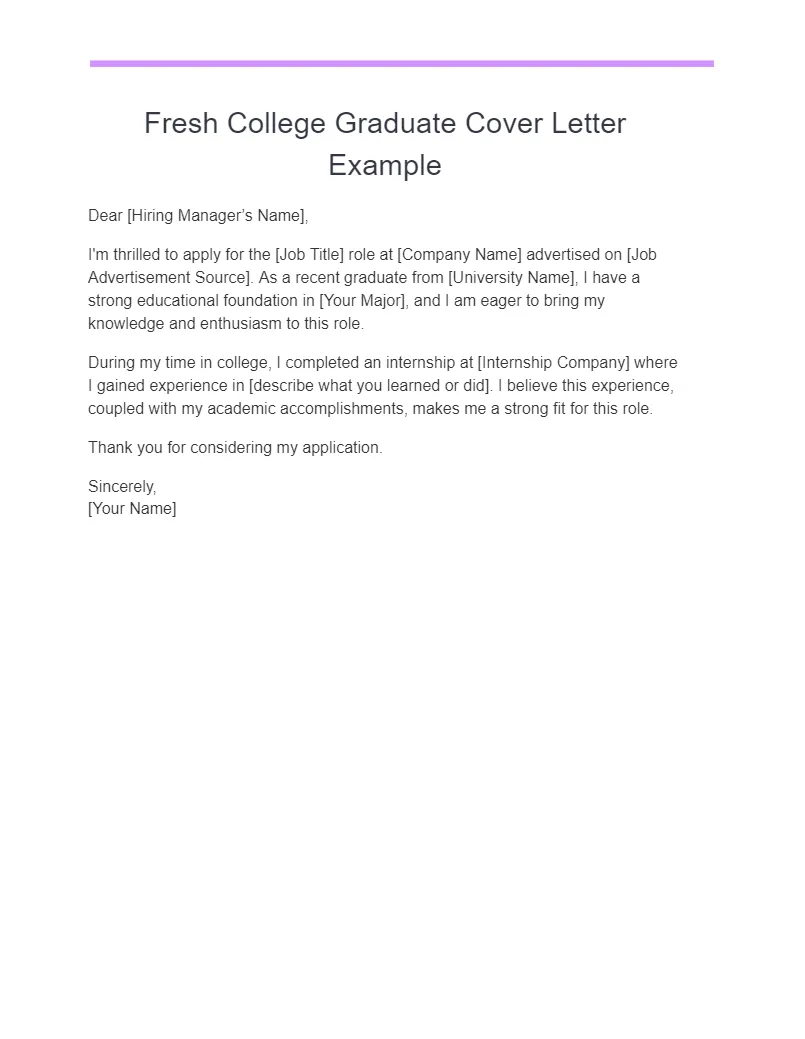
Avoid common mistakes that can undermine your cover letter and negatively impact your application. One of the most frequent errors is sending a generic cover letter that is not tailored to the specific job or company. Always customize your cover letter to demonstrate your understanding of the role and your genuine interest in the organization. Another common mistake is including excessive information that isn’t directly relevant to the job requirements. Keep your cover letter focused and concise, highlighting the most relevant skills and experiences. Grammatical errors and typos can make your application appear unprofessional. Proofread your cover letter carefully to avoid these errors. Don’t use clichés or overly formal language. Write in a clear, concise, and engaging style, showcasing your personality and enthusiasm. Avoid being too wordy or using jargon. Your goal is to clearly communicate your qualifications in a way that is easy for the reader to understand. Before submitting, get a second opinion from someone to catch any errors.
Examples of Strong Cover Letters
Reviewing examples of strong cover letters can provide valuable insight into how to structure and write your own. Search online for sample cover letters for fresh graduates in your field. Pay attention to how the writers highlight their skills, experiences, and achievements. Notice the language used and the tone of the letter. Observe the overall structure and formatting, paying attention to how information is presented. Analyze how the writers tailor their letters to different job descriptions and company cultures. Use these examples as a starting point. Make sure to customize any sample you find to reflect your own qualifications and experiences. Tailor your letter to the specific job and company you are applying for. This will make your application stand out and greatly increase your chances of success. Remember that your goal is to demonstrate your ability to write a compelling cover letter that helps you secure an interview.
Cover Letter for Fresh Graduates Sample
Here is a sample cover letter to guide your own writing: [Your Name] [Your Address] [Your Phone Number] [Your Email Address] [Date] [Hiring Manager Name] [Hiring Manager Title] [Company Name] [Company Address] Dear [Mr./Ms./Mx. Last Name], I am writing to express my enthusiastic interest in the [Job Title] position at [Company Name], as advertised on [Platform]. As a recent graduate of [University Name] with a degree in [Your Major], I am eager to apply my skills and knowledge to a challenging and rewarding role. During my studies, I excelled in [Relevant Coursework/Projects], and I developed strong skills in [Key Skills]. In my role as [Internship/Volunteer Role], I [Specific Accomplishments and Quantifiable Results]. I am particularly drawn to [Company Name] because of [Reasons - e.g., company culture, values, projects]. I am confident that my skills and enthusiasm align with your needs. I am eager to discuss how I can contribute to your team. Thank you for your time and consideration. Sincerely, [Your Typed Name].
Cover Letter for Internship Applications
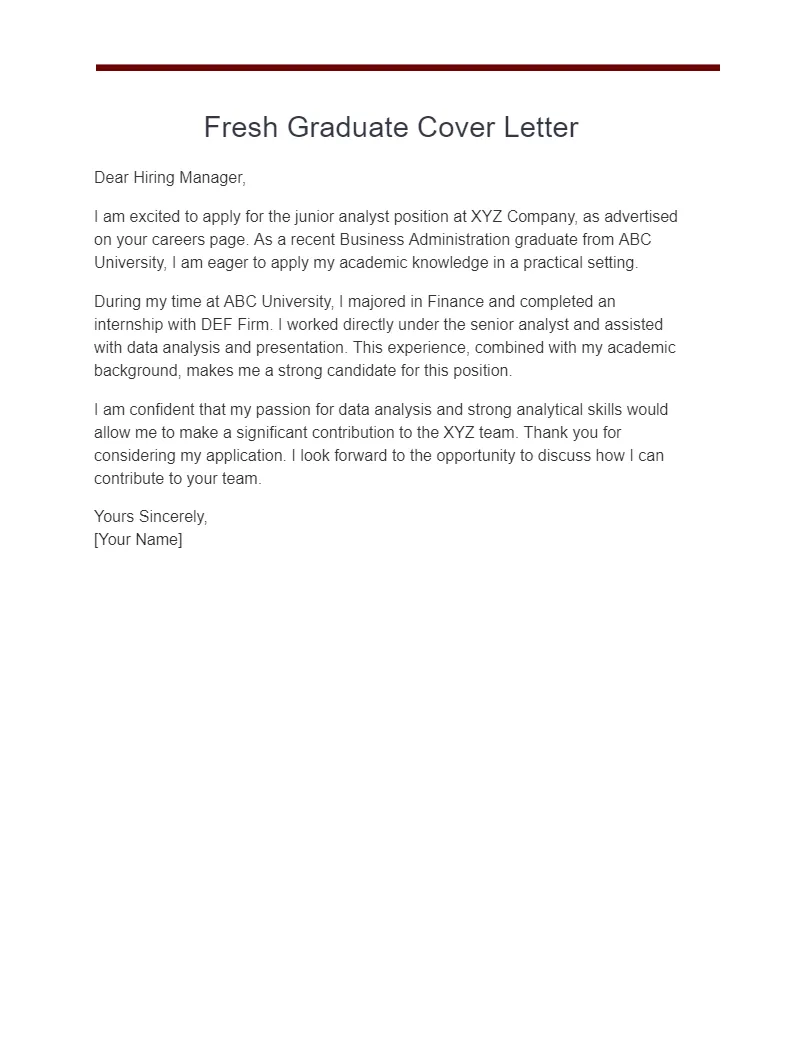
A cover letter for an internship application requires a slightly different approach than a cover letter for a full-time job. As an intern, you will likely have limited work experience, so focus on showcasing your academic achievements, relevant coursework, projects, and any extracurricular activities that demonstrate your skills. Highlight your enthusiasm for the internship and the company. Clearly state your interest in the role and the specific skills you want to develop. Explain what you hope to gain from the internship. If you have prior experience, briefly mention it, focusing on the skills you developed. Quantify your achievements whenever possible. For example, if you managed a project, explain how you improved results or delivered on time. Include examples of your teamwork, communication, and problem-solving abilities. Emphasize your willingness to learn and contribute to the company. Customize your cover letter to the specific internship. Explain why you chose the company and the specific internship role. Make sure to align your goals with the company’s mission and values. Conclude by expressing your gratitude for the opportunity and your enthusiasm for the internship.
Final Thoughts on Cover Letters
Writing a compelling cover letter is an essential skill for fresh graduates seeking to kickstart their careers. It provides a unique opportunity to showcase your personality, highlight your potential, and demonstrate your understanding of the job requirements. Start by researching the company and the role and tailor your letter accordingly. Highlight your skills, education, and relevant experiences. Emphasize your enthusiasm for the position and the company. Proofread your cover letter carefully to ensure it is free of errors and is professionally formatted. By following these guidelines, you can create a cover letter that grabs the reader’s attention and increases your chances of securing an interview. This document is your chance to make a great first impression. Take your time to write a well-crafted and thoughtful cover letter to make your application stand out from the competition. Remember that a great cover letter can open doors and help you land your dream job.
